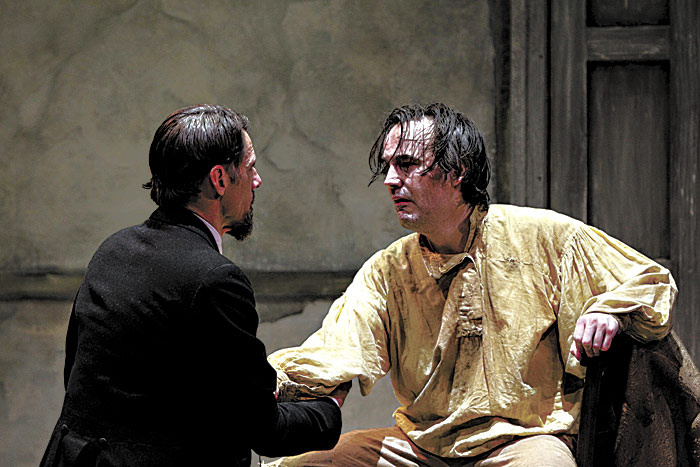Redemption has replaced rendition as the new American watchword, and anyone paying attention to the G-20 summit last week saw the international community breathe a collective sigh of relief as President Obama allowed that yes, we Yanks had a bit to do with the current global economic disaster. A new production of Dostoyevsky’s Crime and Punishment arrives just in time not only for Easter but for our mea culpa on the world stage, too.
This 85-minute dash through the classic Russian novel was last seen in a 2007 Capitol Hill Arts Center production under the same director, Sheila Daniels, and with two of the same actors. Hana Lass again plays all the female roles. And Galen Joseph Osier is Raskolnikov, who turns from academia to homicide all in the name of a proprietary theory.
The way Raskolnikov sees it, murder for a noble cause is justifiable, especially if the perp is “extraordinary” (in this translation), rather than just one of the hoi polloi.You don’t have to look too far to find the parallels. Society is slopping over with forgotten people trying to make names for themselves—violently—in the name of some greater good. The metaphor of the text is also writ large in places like Iraq, Africa, and elsewhere, where demagogues justify wholesale slaughter under the rubric of security, democracy, or peace.
Director Daniels uses Dostoyevsky’s plot to explore the themes of personal responsibility, the prospect of forgiveness, and the way a lifelong sense of powerlessness can cause even the best of us to go aggro. Tough stuff, but well worth the watching, especially as the three actors—including the newcomer to this production, Todd Jefferson Moore, as the detective Porfiry—guide us down this psychological circular stairwell into the mind of a murderer.
We’ve all been in Raskolnikov’s position: ignored, unable to take our lives into our own hands. I can’t even get AT&T to keep me enrolled in their autopay program. Every month I’m pressing #1 to talk to a customer service rep, who wants to refer me to a supervisor, who tells me a technician is working on the problem. Would I like to hold? “No,” I say, “I’d like an ax.” The difference is that Raskolnikov, unlike you or me, picks up that ax and decides to unclutter his life a little.
There are times when Dostoyevsky’s work seems to belabor its points and the denouement seems to telescope away into the distance. It’s only a matter of chatter until Raskolnikov has to face the music. Fortunately, this compact adaptation by Marilyn Campbell and Curt Columbus whizzes through the 500-page novel, condensing the action by rearranging sequences of events and reassigning bits of business from one character to another, focusing on what makes the work most engrossing. Carey Wong’s set, a tilted thrust stage in a small room that changes hue (the walls actually glow at times) to accompany Raskolnikov’s inner and outer battles, is worth the ticket price by itself. (It was a joint creation with lighting designer Dans Maree Sheehan.)
In Daniels’ hands, time becomes taffy. She whips the action scenes into a staccato frenzy, then stretches Raskolnikov’s creeping self-awareness into a kind of water torture, in which, as the poet Aeschylus wrote, “Even in our sleep, pain that cannot forget falls drop by drop upon the heart, and in our own despite, against our will, comes wisdom to us by the awful grace of God.” Under cross-examination by Porfiry, Raskolnikov’s belief that he’s extraordinary begins to crack, until his realization shatters him from the inside out.
Daniels dwells on Porfiry’s affable interrogation scenes; we watch him intellectually disarm, then dismantle, Raskolnikov just as a curious child might gently pull the wings off a fly. It’s glad-handing and cheery, and guaranteed to make your blood run cold.
Similarly, when the killer begs for understanding and forgiveness from Sonia, both Daniels and Lass leave him writhing on the petard of his guilt. Redemption is for those who confess and repent. Daniels drags Raskolnikov’s out at the pace of exsanguination, and that makes witnessing his final implosion all the more agonizing.








